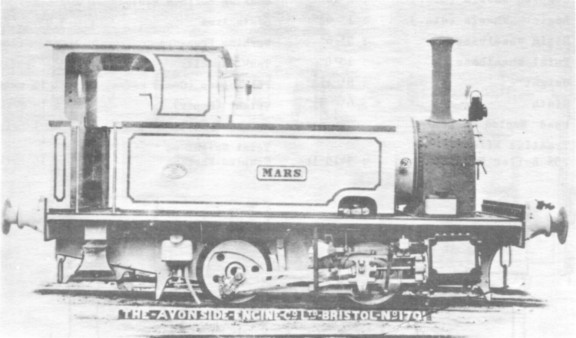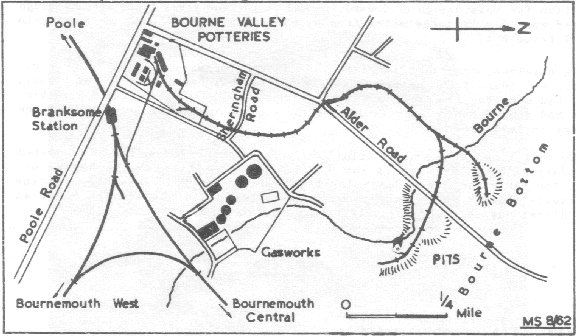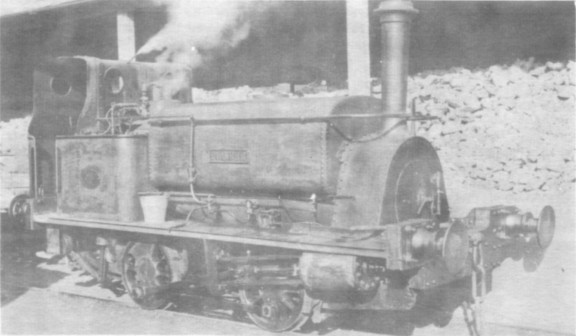
| THE INDUSTRIAL RAILWAY RECORD |
© NOVEMBER 1962 |
THE BOURNE VALLEY
TRAMWAY
By ALAN WILSON
The Bourne river is but a small stream which rises on Highmoor, to the north of Branksome. Flowing generally eastwards it forms part of some attractive public gardens before emptying itself into Poole Bay. The well-known holiday resort which takes its name lies in Hampshire, but the tramway itself was entirely in Dorset.
Sharp, Jones & Company Ltd. established their Bourne Valley Potteries in 1853, and at first worked only the clay in the immediate neighbourhood. In 1886 some additional clay lands were acquired in Bourne Bottom and it was decided to connect these with the dries by means of a standard gauge line some 1Ό miles long. Later a connection was made with the London & South Western Railway just east of Branksome station.
For the first three years the tramway was worked by a stud of thirteen horses pending delivery of the first locomotive. This was supplied new on 28th June 1889 by the makers, Hudswell, Clarke & Company Ltd. of Leeds, works number 336. Named PIONEER, it was an 0‑4‑0 saddle tank with block buffers and a copper firebox. It worked successfully until the advent of the First World War when it was commandeered to work at some sidings adjoining a military depot west of Poole, long since removed. PIONEER was later returned, but in the meantime a second locomotive, ordered in October 1914, had been supplied new in 1915 for £879 by the makers, the Avonside Engine Company Ltd. of Bristol, works number 1701. This was MARS, an 0‑4‑0 side tank with Walschaerts valve gear, and a full cab in contrast to the spartan weatherboard on PIONEER. During the absence of PIONEER, MARS had a boiler overhaul, and a steam crane was hired to do the pottery shunting. Because of the severe gradients, each locomotive was restricted to a load of only one loaded clay truck of about nine tons.
During the inter-war years, the two locomotives were both in steam working long hours of duty, and in 1938 PIONEER was fitted with a new boiler and steel firebox. During the Second World War traffic fell off, and in 1942 MARS was sold through the agency of the Ministry of Supply to the British Periclase Company Ltd at West Hartlepool. PIONEER continued on after the War unaided, but eventually the clay pits became uneconomical to work and in 1948 the tramway was closed. The work of dismantling the track was completed in August of that year, and in September, PIONEER, which had worked the demolition train, was sold for scrap to Tranters of Bournemouth. The siding connection to the Southern Region line is, however, still in use, and since September 1948 has been shunted exclusively by a Muir-Hill road tractor powered by a Fordson petrol engine, which was supplied new in January 1948.
The tramway began at the dries within the main pottery and, running approximately north-eastwards, fell at a gradient of 1 in 22 to the valley floor at Sheringham-road, which it crossed on the level. On the other side, it climbed on a long curve to the rear of what is now a bowling green and recreation ground, and along to Alder-road. Crossing this on the level it continued northwards to a junction. Here, one branch, crossing the Bourne, served the original clay pits near Mount Talbot which closed in the 1920s; the other ran eastwards following the river to more extensive pits on the east side of Alder-road, which it again crossed on the level.
Most of the route can still be traced as that part to the north of Sheringham-road forms a public footpath and, beyond the first crossing of Alder-road, an access to a mew housing estate. Further on and to the east of the formation, several small factories have sprung up.

Leading dimensions of the locomotives are as under:-
|
|
PIONEER |
MARS |
| Cylinders (outside) | 10 x 16 | 10 x 16 |
| Wheels (diameter) | 29 | 29 |
| Wheelbase | 56 | 50 |
| Tank Capacity | 360 gallons | 350 gallons |
| Bunker Capacity | 25 cubic ft. | 15 cubic ft. |
| Weight (empty) | 12 tons (approx.) | ? |
| Weight (full) | 15 tons (approx.) | ? |
| Boiler Pressure | 160 lbs./sq.in. | 160 lbs./sq.in. |
| Tractive Effort | 6,600 lbs | ? |
| Boiler Barrel (diameter) | 29 | 3'3" |
| Boiler Barrel (length) | 79 | 7'61/8" |
| Tubes | 58 of 2 diameter | 90 of 1Ύ diameter |
| Heating Surface (firebox) | 30.47 sq.ft. | 40 sq.ft. |
| Heating Surface (tubes) | 243.13 sq.ft. | 309 sq.ft. |
| Heating Surface (total) | 273.60 sq.ft. | 349 sq.ft. |
| Grate Area | 4.50 sq.ft. | 6 sq.ft. |
My thanks are due to Mr. J. E. Powell of Sharp, Jones & Company Ltd. for providing information about the earlier history of the tramway, to Messrs. G. Horsman and R. N. Redman, and also The Hunslet Engine Company Ltd. who kindly permitted reproduction of the official photograph of MARS.
The following map and picture were actually carried over and printed in issue No.2, but are shown here for convenience:


PIONEER at the Bourne Valley Potteries on 30th August 1944. (L.W. Perkins)